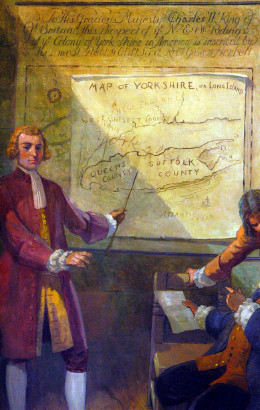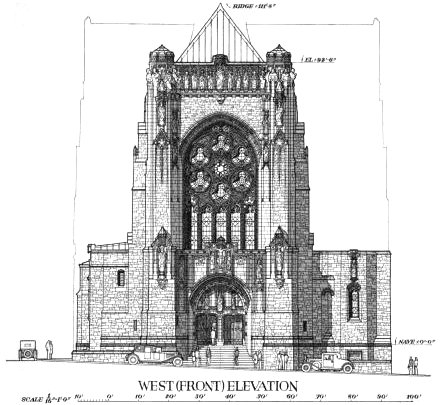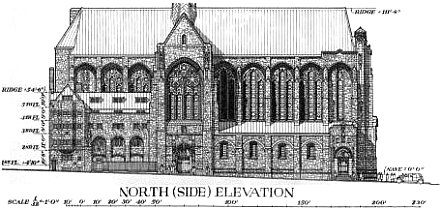New York
About Andrew Cusack
 Writer, web designer, etc.; born in New York; educated in Argentina, Scotland, and South Africa; now based in London.
Writer, web designer, etc.; born in New York; educated in Argentina, Scotland, and South Africa; now based in London. read more
News
Blogs
Reviews & Periodicals
Arts & Design
World
France
Mitteleuropa
Knickerbockers
Argentina
The Levant
Africa
Cape of Good Hope
Netherlands
Scandinavia
Québec
India
Muscovy
Germany
Academica
Fighting 69th: Home for St. Patrick’s Day
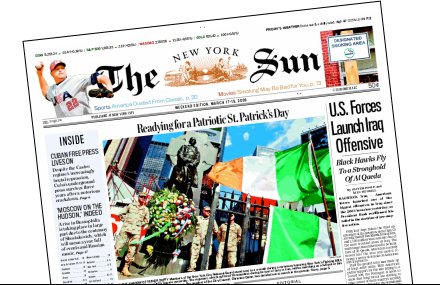
IN THE SHADOW OF FATHER DUFFY: Members of the New York City National Guard (sic) stand next to a wreath during a ceremony honoring New York’s Fighting 69th at Times Square’s Father Duffy Square (sic) yesterday. The regiment, which suffered 19 casualties during its tour of duty in Iraq, will be marching as a full unit in this year’s St. Patrick’s Day Parade on Fifth Avenue. The speaker of the City Council, Christine Quinn, has decided not to march in the parade. Story, page 3.
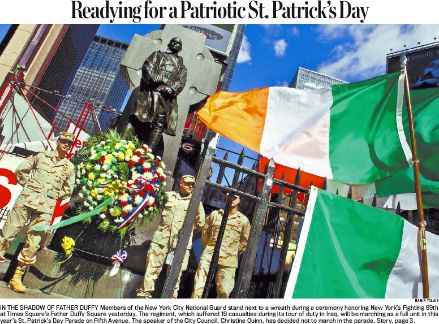
Despite the inaccuracies (it’s the New York National Guard, not New York City National Guard, and Father Duffy Square is opposite Times Square, not in it), it’s nice to see one of the Empire State’s greatest regiments remembered in the press, and on no less than the front page.
Further:
A Pat on hero’s back — Fighting 69th vet to lead parade in honor of slain pal (New York Daily News)
The Governor’s Suite, City Hall
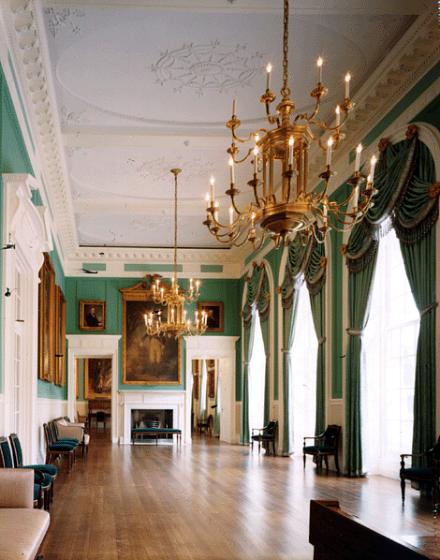
I HAVE NEVER been inside New York’s City Hall, though I have walked or driven past it on a number of occasions. With tall skyscrapers of various ilks towering over it, it always seemed rather small and inconsequential, and I knew nothing of the interiors save the Blue Room in which the Mayor usually gives press conferences and the rotunda which is fairly well-known as well.
I was delighted, therefore, to stumble upon the above photo of the recently-restored Governor’s Suite in City Hall, which shows it to have a rather handsome interior. Since the state government embarked upon an up-river journey to Albany, I presume the purpose of the Governor’s Suite is to provide a place for New York’s head of state to receive and entertain important dignitaries visiting the Big Apple. The current green color of the walls seems much preferable to the previous and rather dull white. I must endeavour to visit City Hall when I next return to the metropolis. (more…)
The Eastchester Covenant
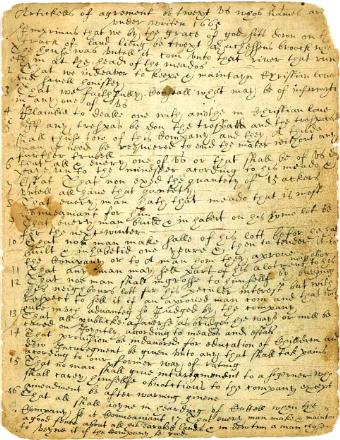
The Town of Eastchester, New York was settled in 1664 and in the following year the English inhabitants thereof drew up a covenant binding all the townsfolk. Among the various articles within this foundational tract are sensible pronouncements guaranteeing the rights of private property, forbidding trespassing, and a promise to “indeavor to keepe & maintayn Christian love and sivell honesty”.
My favorite part, however, is article 15, stating that “no man shall entertain obnoxious foreigners”.
Monster Swallows Village Whole
‘But will it give birth?’ the Villagers Inquire
“NYU is the largest private university in the United States and they are growing,” Andrew Berman, executive director of the Greenwich Village Society for Historic Preservation, told Community Board 2 Thursday night. “They are growing at a much faster pace than our neighborhood is. NYU has always been here. It should always be here. I don’t think the Village would be the Village if NYU wasn’t here. But I don’t think the Village can stay the Village if it is predominantly NYU.” And so a new campaign to get NYU to check it’s own expansions in the Village by creating a “secondary campus” begins. [Gothamist]
A secondary campus such as, for example, the one they sold off in 1979? I would have to concur that NYU has grown rather too large for the Village’s britches, and the fact that NYU is trying to build a towering dormitory where St. Ann’s once stood doth not encourage feelings of merriment (though, of course, the blame for that belongs mostly to our archbishop from the Middle West). At any rate, perhaps NYU can strike a deal and buy back the University Heights campus. Unlikely, since the City University of New York which now owns the campus (run as Bronx Community College) would probably like to see itself as a competitor to NYU (it isn’t; they’re leagues apart).
Of course one idea is to stop expanding and maintain the current size and facilities of the university, but this is unlikely. NYU have displayed a Hitlerian glee in the acquisition of neighboring properties, and, to stretch the analogy beyond any rational use, Fordham, St. John’s, and Columbia have no strategic interest in acting as the UK, US, and Soviet Union (respectively) in uniting to counter that expansion.
Previously: Thoughts on NYU et cetera | Back in the Day | New Washington Square Plans | NYU – Old & New
New York in the Early Republic
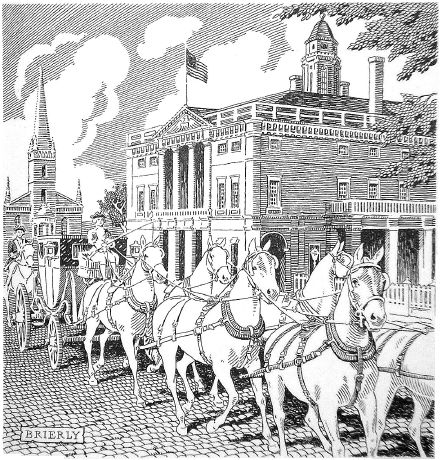
IT IS NOT OFTEN remembered that New York was the first capital of the United States and, as such, was home to the executive, legislative, and judicial branches of the new republic, albeit only for a short time. Federal Hall (above, with the Presidential carriage) was originally constructed in 1699 as a City Hall for New York. It was in this building at 26 Wall Street in 1735 that John Peter Zenger was tried and acquitted of libeling the Governor, affirming the Freedom of the Press. The Continental Congress began meeting in the City Hall in the 1780’s, and with the ratification of the new Constitution of the United States it became the first home of the federal government. Having been elected the first President of the United States, General George Washington was inaugurated on the balcony of the building on April 30, 1789. (more…)
Fresh Kills

Hail, rustic metropolis! I’d file this view of Fresh Kills on Staten Island under ‘You’d Never Believe You’re In New York City‘. The name might seem odd to those who aren’t either New Yorkers or Dutch. ‘Kill’ is a common placename in the Empire State, from the Middle Dutch ‘kille’ meaning riverbank or channel of water. Exempli gratia Arthur Kill, Kill van Kull, Fishkill, and Peekskill in New York, or the Schuykill River in Pennsylvania.
Previously: Rowing in Pelham Bay
The Queen Mother in New York, 1954
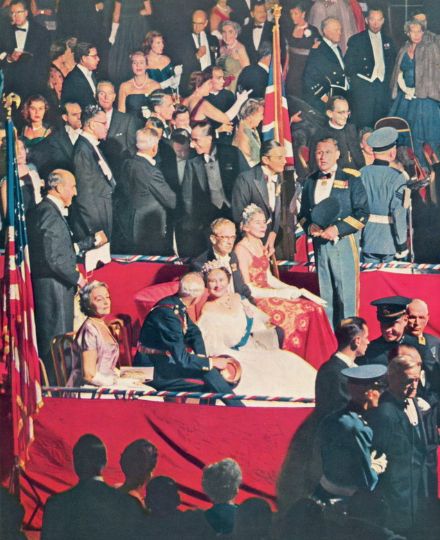
In 1954 Queen Elizabeth, the Queen Mother (n.1900, m.2002) visited New York to accept an educational fund raised by Americans in memory of the late King George VI. On the evening of November 1 of that year, the Seventh Regiment entertained Her Majesty with a special ball held in her honor at the Armory on Park Avenue (view above). Her Majesty also visited the Cathedral of St. John the Divine where she was received by the (Episcopal) Bishop of New York, the Dean, and the clergy of the Cathedral. The three stone blocks on the façade seen in the view below have since been sculpted.
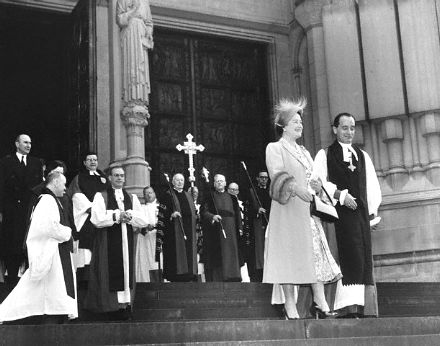
Savoy in New York
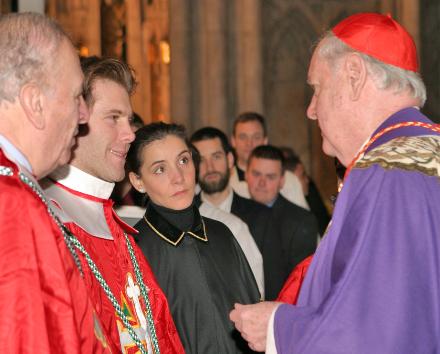
New York recently played host to the Prince and Princess of Venice and Piedmont, Emanuele Filiberto and Clotilde of the House of Savoy. Emanuele Filiberto is the son and heir-apparent of HRH Vittorio Emanuele the Prince of Naples (Vittorio Emanuele IV) who currently lives in voluntary exile from the Italian Republic. The laws forbidding the House of Savoy from visiting and living in Italy were finally overturned in 2002.
The two day visit to New York organized by the American Delagation of Savoy Orders culminated in a Solemn Mass in St. Patrick’s Cathedral on January 6 said by His Eminence Cardinal Egan, himself a Cavaliere di Gran Croce. About three dozen members of the orders of the House of Savoy attended the Mass with friends and family.
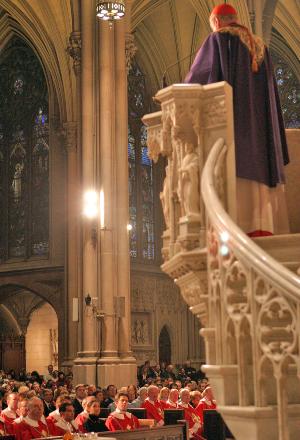
The 7th Regiment in Washington Square
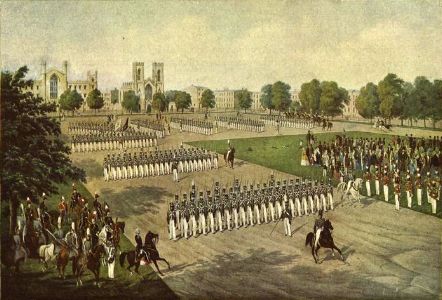
Entitled “National Guard – 7th Regiment New York State Militia”, this mid-nineteenth century view shows the famous 7th Regiment of New York, nicknamed the Silk-Stocking Regiment, parading in Washington Square. In the background can be seen the University of the City of New York and the Church of St. Thomas, which has since moved to Fifth Avenue in Midtown.
Thomas Dongan, 2nd Earl of Limerick
AS VIRGINIA, a year short of four centuries since her foundation, has only recently inaugurated her first Catholic governor, it might be an appropriate time to remember the first Catholic governor of New York, Thomas Dongan (right). Dongan’s tenure as Governor of the Province of New York was one of the most important in the history of our land, and witnessed the formative period of responsible government in what would eventually become the Empire State.
Thomas was born in 1634, the youngest son of Sir James Dongan, Bt., a Member of the Irish Parliament. After the regicide of Good King Charles in 1649, the Catholic family feared persecution and fled to France, as did the Royal Family. In France, having Gallicized his surname to D’Unguent, Thomas joined an Irish regiment and fought under the Vicomte de Turenne (who himself, born into Calvinism, became a Catholic in October 1668). Despite the Restoration of the Crown in Britain and Ireland, Dongan remained in France, being promoted to colonel in his fortieth year. The 1678 Treaty of Nijmegen, however, required all of Charles II’s subjects in the service of France to return home, and so Thomas obliged. Through the efforts of James, Duke of York, with whom Dongan had the privilege of serving in the French Army, he was granted a pension, a high-ranking commission, and was appointed Lieutenant-Governor of Tangiers, of all places, which (along with Bombay) had been given to England as part of the dowry of Catherine of Braganza.
It was in 1682 that James, Duke of York, as Lord Proprietor of New York, appointed Thomas Dongan to govern the bankrupt colony. “In this office,” the Catholic Encyclopedia says, “Dongan proved himself an able lawgiver, and left an indelible mark on political and constitutional history.” He convened the first representative assembly of the Province in 1683, which enacted the Charter of Liberties enunciating the form of government in New York. The Duke of York’s supreme legislative power as Lord Proprietor would reside in a governor, council, and general assembly. Members of the assembly were conferred rights and privileges making their august legislature coequal to and independent of Parliament. Courts of justice were established, liberty of conscience regarding religion was declared, and the principle of no taxation without representation was affirmed. Dongan signed the Charter of Liberties on 30 October 1683, and solemnly proclaimed it the next day at the Stadt Huys, New York’s city hall.
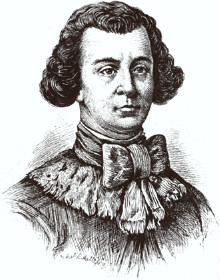 “Thus to Dongan’s term as governor,” quoth the Encyclopedia, “can be dated the Magna Charta of American constitutional liberties, for his system of government became the programme of continuous political agitation by the colonists of New York Province during the eighteenth century. It developed naturally into the present state government, and many of its principles passed into the framework of the Federal Government. Moreover, a rare tribute to his genius, the government imposed by him on New York Province, 1683, was adopted by England after the American War of Independence as the framework of her colonial policy, and constitutes the present [1909] form of government in Canada, Australia, and the Transvaal.”
“Thus to Dongan’s term as governor,” quoth the Encyclopedia, “can be dated the Magna Charta of American constitutional liberties, for his system of government became the programme of continuous political agitation by the colonists of New York Province during the eighteenth century. It developed naturally into the present state government, and many of its principles passed into the framework of the Federal Government. Moreover, a rare tribute to his genius, the government imposed by him on New York Province, 1683, was adopted by England after the American War of Independence as the framework of her colonial policy, and constitutes the present [1909] form of government in Canada, Australia, and the Transvaal.”
The peace and harmony of the Province was furthered in 1684 when Dongan, in the presence of Lord Howard, the Governor of Virginia, received the voluntary submission of the Iroquois confederacy to “the Great Sachem Charles”. The following year saw the death of Charles II and the ascent of the Lord Proprietor, James, Duke of York, to the thrones of England, Scotland, and Ireland. In that year of 1685, Dongan established a Post Office to strengthen communications within his colony and between all the English colonies in America. In the next year, 1686, the Governor granted civic charters to New York and Albany. Dongan’s charter for the City of New York lasted 135 years, while that of Albany was only replaced in 1870. Avid historians would have been bemused/irritated by Archdiocese’s celebration just a few years ago of the two-hundredth anniversary of Catholic education in New York. This would be because New York’s first Catholic school was not in the 1800’s during the republic’s early years but in the 1680’s when Governor Dongan established a college (in the secondary sense) under the guidance of three Jesuit priests, one of whom was his own private chaplain.
Despite the brief attempt to merge New York and New England, followed by the overthrow of James, our last Catholic king, in the so-called ‘Glorious Revolution’, Governor Dongan’s legacy in establishing the institutions of responsible government in New York remains. Indeed he was unquestionably New York’s greatest governor until the advent of ‘Magnus Apollo’ himself, DeWitt Clinton, in the nineteenth century. With the new Protestant Williamite administration in charge, Thomas Dongan returned to England in 1691 and, with the death of his elder brother, inherited the Earldom of Limerick under its first (1686) creation. He died in 1715, poor and childless. Nonetheless, as the Encyclopedia notes:
The tribute of history to his personal charm, his integrity, and character, is outspoken and universal. His public papers give evidence of a keen mind and a sense of humour. He was a man of courage, tact, and capacity, an able diplomat, and a statesman of prudence and remarkable foresight. In spite of the brief term of five years as Governor of New York Province, by virtue of the magnitude, of the enduring and far-reaching character of his achievements, he stands forth as one of the greatest constructive statesmen ever sent out by England for the government of any of her American colonial possessions.
Soggy Manhattan
Ah, Manahatta. Even on a day as soggy as this, the Upper East Side still charms me. It also retains a fair number of buildings from the days when New York had higher tastes, mostly to be found between Fifth and Park Avenues. It is a fact to be mourned that we have probably destroyed most of what was good in New York’s built environment. Nonetheless, we should of course be glad for the beautiful things which remain from our great city’s golden age, and thankfully they are not a mere handful.
Stumbling down East 82nd Street this afternoon amongst puddle, gloom, and rain I emerged onto Fifth Avenue to see the beautiful mass of the Metropolitan Museum of Art revealed in all its glory. The façade of the Met has recently been cleaned and glancing at it today, despite the cloud and percipitation, one could almost imagine the year as 1902 when the wing designed by Richard Morris Hunt was completed. This is doubly so because the Metropolitan currently lacks her usual ungainly vexillic adornments pronouncing the exhibits shown in her distinguished galleries. These banners add nothing to the Met’s façade, and if there is a more clever and handsome way of announcing what is within without – and surely there must be – the Museum does not seem to have found it.
Still, the situation is not as reprehensible as across Central Park at the American Museum of Natural History. The AMNH enjoys two façades, one of which commands the view over Central Park West and the park itself beyond. The main portion of the Museum’s Central Park West front is a brilliant triumphal arch which is in fact the State of New York’s monument and memorial to Theodore Roosevelt, President of the United States and Governor of New York during his earthly life. Shamefully, the Museum disrespects this great monument to this great man by covering it in advertising banners akin to those which usually mar the Metropolitan. The American Museum of Natural History should be ashamed of itself for sullying such an august and dignified locale for the purposes of selfish marketing.
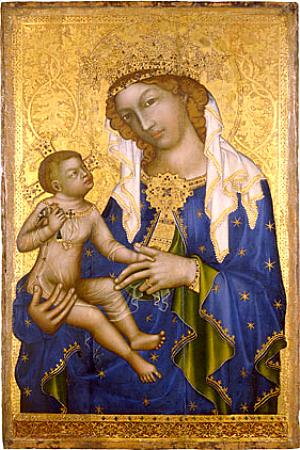
Tempera and gold on panel; 35′ x 23′
Deacon’s Office, Zbraslav/Koenigsaal/Aula Regia
(on loan to the National Gallery, Prague)
What brought me to plod up the splendid elevating staircase of the Metropolitan was to catch – just barely, for this was its last day – the special exhibition entitled Prague: The Crown of Bohemia 1347-1437. I had first gotten wind of this showing flipping through the mail whilst I was still interning at the New Criterion at the end of the summer and duly noted in my diary that though it opened while I was away in Scotland it would still be open upon my return for the Christmas holiday. Anyhow, I finally took advantage of it today and it was much enjoyed. What a remarkable land is Bohemia. The exhibit served only to augment my interest in the country and I must be sure to spend some time there sooner or later.
In addition to the Mother and Child above, the exhibit presented the tabernacle shown below (photographed in its actual home). There were also many, many reliquaries, some of which appeared to still have relics in them. One would have thought a museum’s interest in a reliquary was purely artistic and thus that the relics involved would be removed and handed over to those who would give them the care they deserve. Does the Museum have a consultant to advise on these cases, I wonder? Anyhow, I was sure to touch the glass and ask the saints to pray for us, just in case. The Bohemians clearly knew how to treat relics, would only that New Yorkers did – though to be fair I am told that the Tour of the Relics of St. Thérèse of Liseux which made its way to New York just a few years ago was well attended in the Metropolis and even up in Westchester round my neck of the woods. There is a relic of our dear Thérèse available for veneration in St. Patrick’s Cathedral which I occasionally drop in on when in the neighborhood.
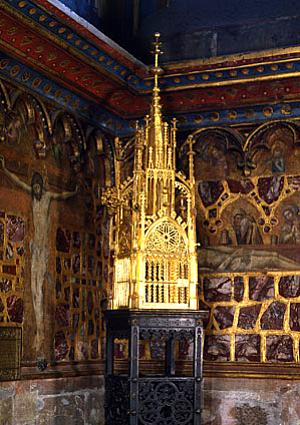
At any rate, had I attended Prague: The Crown of Bohemia 1347-1437 earlier I would’ve enjoined the reader to pay it a visit, but since it has finished its run I instead enjoin our dear readers to at least saunter down Fifth and stop to savor a glance of the cleaned-up Metropolitan sans banners. No doubt it will not be free of them for long — unless they who direct the Museum have had a moment of grace.
Previously: The Remarkable Hapsburgs | Brünn
Governors Island
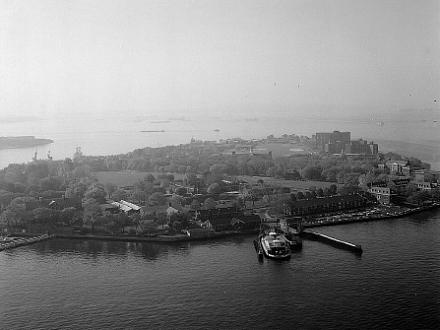
GOVERNORS ISLAND IS one of New York’s hidden gems. Not only is it a place which has a long and storied history, but it remains, however underappreciated, a place of great beauty, not to mention a place of great potential. The fact that this island in New York Harbor has been the property of the government for the preponderance of its existence has shielded it from the destructive forces of commerce which have savaged so much of what is beautiful and historic in the remainder of the city.
Let us explore this intriguing isle… (more…)
Bronxville Institutions and Their Land
I tabulated the following for a number of institutions in the Village of Bronxville: name of institution, tax-assessed value of property, total size of property (unreliable), and number of properties owned. The results are not surprising. The top five in terms of value are, in order, the village’s only college, the hospital (where I was born), the public school, the village government itself, and the main church. (I think the stats on acreage are generally unreliable).
| Name |
Value ($) |
Acres |
No. of Props |
| Concordia College |
160,202,500 |
6.53 |
7 |
| Lawrence Hospital |
125,362,500 |
.55 |
2 |
| Bronxville School (Public) |
91,630,000 |
? |
2 |
| Village of Bronxville |
49,690,000 |
15.18+ |
24 |
| Dutch Reformed Church (R.C.A.) |
45,297,500 |
3.83 |
3 |
| Church of Saint Joseph (Archdiocese of New York) |
25,245,000 |
3.73+ |
7 |
| U.S. Post Office |
18,605,000 |
.54 |
1 |
| Westchester County Park Commission |
18,007,000 |
10.23 |
9 |
| Christ Church Episcopal |
15,593,750 |
.75 |
3 |
| Village Lutheran Church (L.C.-M.S.) |
13,752,500 |
2.33 |
4 |
| Taconic State Parkway Commission |
5,430,000 |
1.36 |
3 |
| Fire District Town of Eastchester (Bronxville Fire Station) |
3,465,000 |
.34 |
1 |
| First Church of Christ Scientist |
3,432,500 |
2.88 |
2 |
| Bronxville Women’s Club |
1,321,000 |
.9 |
5 |
| Town of Eastchester |
540,000 |
2.74 |
3 |
Source: http://www.bronxville.us/
A Sunny Winter’s Day in Eastchester
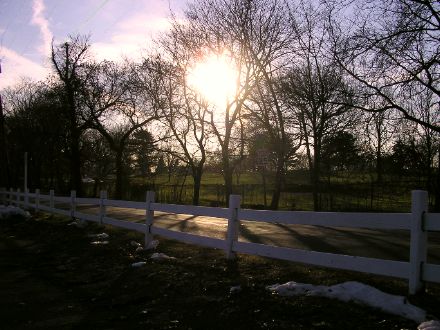
The sun was out today which made it ever so slightly warm in a most welcome way. I managed to get all my Christmas shopping done, which brought forth a great sense of satisfaction. That aside, I thought I’d share a few photos of here and there I took today. (more…)
Well Boo Hoo for the TWU!
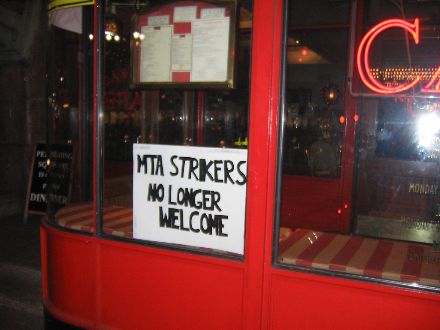
Well, the Great Transit Strike of 2005 is over with the Transport Workers Union having succeeding in winning for themselves the enmity of the entire city. The Trinidadian Roger Toussaint was elected head of the TWU on a radical platform and radical is what they got. And boy did it blow up in their faces! Listening to the radio the other day I heard stories of decent hard-working people who were waking up at 3:30 in the morning so that they could walk to their jobs and get there on time. Others were sleeping in impromptu locations at their place of employ. All this hassle just because Roger Toussaint wanted his pampered transit workers to retire at 55. Well boo hoo!
One Knickerbocker said: “Roger Toussaint gave up a life of hard work picking sugar cane down in the islands to come up to New York and pick the pockets of decent, hard-working Americans instead!” Well at least it’s all over now, so I can finally catch the Prague exhibit at the Met (oh and the Fra Angelico). I still curse myself for missing the Byzantium exhibit they held; I turned up a day late so I and the young lady who accompanied me assuaged our ire at J.G. Melon’s.
Whilst perusing the British corner of the Hudson Newsstand in Grand Central, waiting for a train home last Sunday after hearing Mass at St Agnes and then attending the Festival of Nine Lessons and Carols at St Thomas, I chanced upon a copy of This England, a splendid and reactionary quarterly from that green and pleasant land. It was something of a rediscovery as I have somewhere two copies of This England from 1983 and I am happy to report that the magazine has changed very little. It is a wonderful collection of little articles, stories, anecdotes, and charivari about the Mother Country and doesn’t give the slightest hoot for political correctness. A cozy and comfortable quarterly which I believe any traditionalist from the English-speaking world will enjoy. Irritatingly they did not have the Christmas double edition of the beloved Spectator, so I fear I must do without it this year. (And there was much gnashing of teeth…).
The Festival of Nine Lessons and Carols was superlative as always. It was interesting to note that in the program/weekly bulletin the word ‘Episcopal’ was nowhere to be found, nor any indication that St. Thomas is a parish of the Episcopal Diocese of New York and likewise the Episcopal Church of the United States of America except a very brief statement mentioning that the parish is “in the Anglican tradition”. A parish in denial? Perhaps, but if you were in their situation would you want to face facts? Ignorance is bliss, and it was a blissful service after all. Much enjoyed. My only complaint was that I thought the choir could’ve put a little more oomph in the final verses of Once in Royal David’s City and O Come All Ye Faithful, perhaps with a little help from the organ, but oh well, I’m no choirmaster, deo gratias.
Almost everyone in our little arrondissement of the web has been chiming in with their thoughts on the recent Chronicles of Narnia film, The Lion, the Witch, and the Wardrobe. I have little to contribute other than to say I found it an enjoyable film which I warmly encourage others to see. We found Father Christmas’s lack of headgear disappointing. A mitre would’ve been most appropriate, but his head was bare; perhaps Saint Nicholas should look to the much-vaunted final word in matters sartorial currently sitting on the throne of Peter.
Speaking of matters sartorial, a kerfuffle recently erupted in Missouri when some Communist enemy of all that good and holy banned a kilted student from a high school dance on the grounds that he was not properly attired. If I can trust my profound study of Scottish history (which consists mostly of the first few minutes of that 1959 biopic of John Paul Johns in which Robert Stack plays the title role) then we recall that the boorish Hanoverians banned the kilt for reasons I have forgotten. (I haven’t seen the film in years, and Robert Stack is dead, r.i.p.). I am certain that my readers and I are united in scorn.
I called up the folks at the New Criterion yesterday and Cricket Farnsworth, that hilarious and ever-charming daughter of Connecticut, answered the phone. I asked if there were any commuting woes and Cricket, the token liberal on the staff, just said “Well of course everyone here thinks the union leaders should all be shot.” “Then all is as it should be, Cricket,” I replied, “all is well in the world.” Happily, they have put one of the Jacksons’ Roger Kimball gingerbread men (or ‘Kimballbreadmen’ as they are calling them) to the side for me to consume when I pop down and visit next week. All is well indeed.
New York Currency
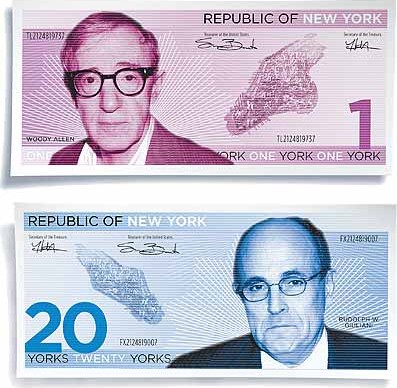
When New York magazine speculated on the prospects of an independent New York they postulated Woody Allen gracing a “1 York” note with Rudolph Guliani on the “20 York” note. In Caledonia they’re used to dealing with many different varieties of banknotes. In Scotland alone there are three different institutions authorised ot print currency: the Royal Bank of Scotland, the Bank of Scotland, and the Clydesdale Bank. Northern Ireland, meanwhile, has four: the Bank of Ireland, Ulster Bank, Northern Bank, and First Trust Bank. England and Wales, on the other hand, have but the Bank of England to issue legal tender, that institution having been granted a monopoly so to do in 1921. [More on British banknotes]
Nonetheless, this got me to thinking who and what I would put on New York bank notes if we had them. First of all, none of this “York” business; dollars they are and dollars they would remain in my land of fancy. Anyhow, here’s what I generally came up with: (more…)
O Blessed Nicholas
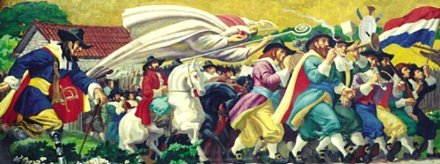
A very happy and blessed St. Nicholas Day to you all. St Nicholas is, as you all know, the patron saint of New York owing to our Netherlandish forefathers. Above you can see Lumen Martin Winter’s mural of St. Nicholas leading Peter Stuyvesant’s legion on their way to attack and take the Swedish fort of Christiania in New Sweden. The account of the battle by Washington Irving is hilarious and counts among my favorite selections of comic writing.
If you’d like to learn more about St. Nicholas, the St. Nicholas Center is a good place to start, as well as the holy bishop’s entry in the Catholic Encyclopedia.
It’s also Sofie von Hauch’s birthday. Tillykke med Fødselsdagen!
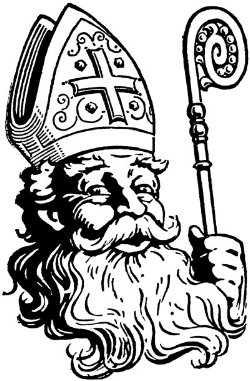
Previously: The Feast of St Nicholas
New York & St Andrews
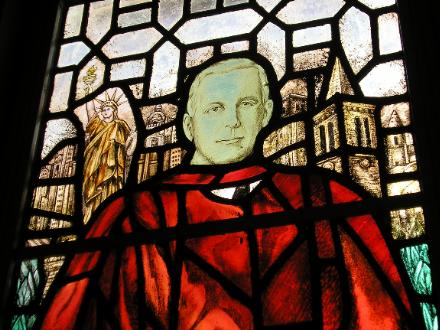
One of the interesting things about living in St. Salvator’s Hall is that one of the beautiful stained-glass windows in our wood-panelled dining hall is dedicated to Edward Harkness, and contains depictions of both the Big Apple and the Auld Gray Toon. Harkness was a benefactor of the University of St Andrews; in fact, he built St. Salvator’s Hall, as well as funding the renovation of the University Chapel (St. Salvator’s) and the restoration of the ruined St. Leonard’s Chapel. (more…)
The Great War Victory Arch
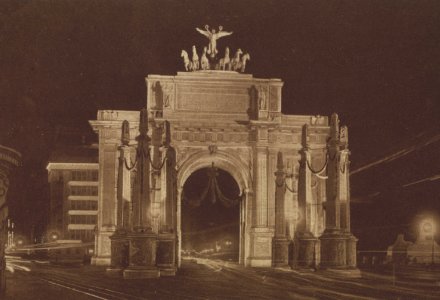
The intersection of Broadway and Madison Avenue sure is the popular place for temporary triumphal arches. After the little shootout with Spain we had a great victory parade and built the Dewey Arch for the triumphant American soldiers and sailors to march under. It also seems that we built a temporary arch for the troops returning from the First World War, photographs of which you can see above and below. The Dewey Arch is more pleasing, if you must know my thoughts upon it, but it’s still rather comely in its own right.
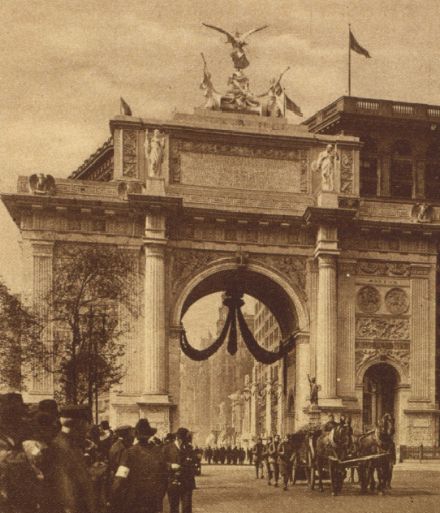
Search
Instagram: @andcusack
Click here for my Instagram photos.Most Recent Posts
- Amsterdam November 26, 2024
- Silver Jubilee November 21, 2024
- Articles of Note: 11 November 2024 November 11, 2024
- Why do you read? November 5, 2024
- India November 4, 2024
Most Recent Comments
- on The Catholic Apostolic Church, Edinburgh
- on Articles of Note: 11 November 2024
- on Articles of Note: 11 November 2024
- on Why do you read?
- on Why do you read?
- on University Nicknames in South Africa
- on The Situation at St Andrews
- on An Aldermanian Skyscraper
- on Equality
- on Rough Notes of Kinderhook
Book Wishlist
Monthly Archives
Categories

